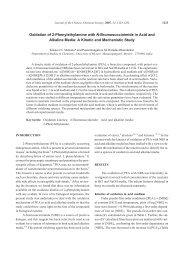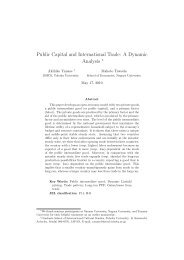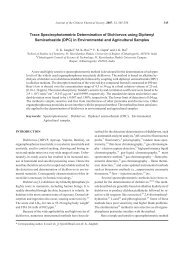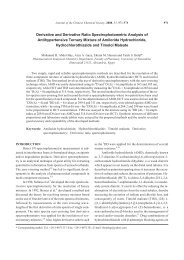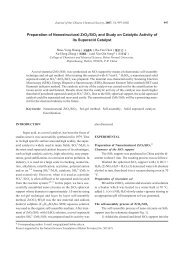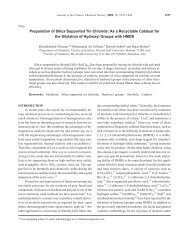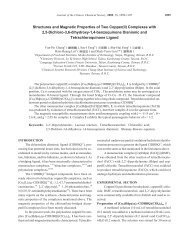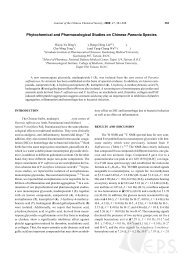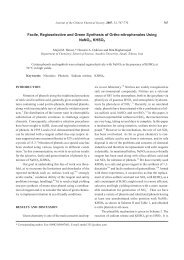Biotinylation of Peptides/Proteins using Biocytin Hydrazide
Biotinylation of Peptides/Proteins using Biocytin Hydrazide
Biotinylation of Peptides/Proteins using Biocytin Hydrazide
Create successful ePaper yourself
Turn your PDF publications into a flip-book with our unique Google optimized e-Paper software.
<strong>Biotinylation</strong> <strong>of</strong> <strong>Peptides</strong>/<strong>Proteins</strong> <strong>using</strong> <strong>Biocytin</strong> <strong>Hydrazide</strong><br />
Bao-Shiang Lee,* Sangeeth Krishnanchettiar, Syed Salman Lateef and Shalini Gupta<br />
Protein Research Laboratory, Research Resources Center, University <strong>of</strong> Illinois, 835 S. Wolcott Avenue,<br />
Chicago, Illinois 60612, USA<br />
<strong>Biocytin</strong> hydrazide is widely used to biotinylate the carbohydrate moieties <strong>of</strong> glycoproteins. In this<br />
study, however, biocytin hydrazide was found to be able to directly biotinylate peptides and proteins. This<br />
phenomenon may cause false identification <strong>of</strong> non-glycopeptides/non-glycoproteins as glycopeptides/<br />
glycoproteins. Here, we report a systematic investigation <strong>of</strong> the reaction <strong>of</strong> peptides/proteins with biocytin<br />
hydrazide. Matrix-assisted laser desorption/ionization time-<strong>of</strong>-flight mass spectrometry is used to analyze<br />
the biotinylation reaction between peptides/proteins and biocytin hydrazide. <strong>Peptides</strong>/proteins were reacted<br />
with biocytin hydrazide in diverse solvent systems with different biocytin hydrazide concentrations<br />
for up to 96 h at temperatures ranging from 4 Cto65C. Singly biotinylated or multiply biotinylated peptides/proteins<br />
are observed. The efficiency <strong>of</strong> the biotinylation reaction increases with higher temperature,<br />
higher biocytin hydrazide concentration, or longer reaction time. The influence <strong>of</strong> buffer pH on the<br />
biotinylation reaction <strong>of</strong> peptides/proteins is less pronounced. The biotinylation efficiency is optimum at<br />
neutral pH. Data suggests that the peptides are biotinylated as efficiently as proteins. The observation that<br />
peptides/proteins condense only with biocytin hydrazide, 2-iminobiotin hydrazide, adipic dihydrazide<br />
and phenyl hydrazine but not with biocytin HCl and 2-iminobiotin, indicates that the biotinylation reaction<br />
<strong>of</strong> peptides/proteins occurs with the hydrazide moiety but not with biotin moiety <strong>of</strong> the biotinylated<br />
reagent. The postsource decay data <strong>of</strong> biotinylated P14R indicates that biocytin hydrazide condenses with<br />
the guanidino group <strong>of</strong> arginine’s side chain <strong>of</strong> P14R, indicating that besides N-terminal and lysine residue<br />
<strong>of</strong> peptides/proteins, arginine residue is capable <strong>of</strong> reacting with biocytin hydrazide.<br />
Keywords: <strong>Biocytin</strong> hydrazide; <strong>Peptides</strong>; <strong>Proteins</strong>; <strong>Biotinylation</strong>; MALDI-TOF MS.<br />
INTRODUCTION<br />
The biotin-avidin system is widely used in many biochemical<br />
techniques 1 for its strong non-covalent biotinavidin<br />
bonding with a dissociation constant <strong>of</strong> ~10 -15 M.<br />
One <strong>of</strong> such techniques uses biocytin hydrazide to label oxidized<br />
glycoproteins. 2 The process involves oxidation <strong>of</strong><br />
the glycoproteins by iodate to convert the hydroxyl residues<br />
<strong>of</strong> the sugar into reactive aldehyde. After that, a hydrazone<br />
bond was formed by reacting biocytin hydrazide with<br />
aldehyde. Subsequently, biotinylated protein is captured<br />
and analyzed by bioanalytical techniques. 2-6 However, the<br />
non-specific reactions between peptides/proteins and biocytin<br />
hydrazide remain to be understood. The non-specific<br />
reactions occur through the interaction <strong>of</strong> amino groups <strong>of</strong><br />
peptides/proteins with the hydrazide group <strong>of</strong> the biocytin<br />
hydrazide, presumably similar to the transamination reaction<br />
<strong>of</strong> biotin hydrazide with cytidine residues in DNA. 2,7-11<br />
Journal <strong>of</strong> the Chinese Chemical Society, 2007, 54, 541-548 541<br />
* Corresponding author. Tel: (312) 996-1411; Fax: (312) 996-1898; E-mail: boblee@uic.edu<br />
In this study, we conduct a study on biotinylation <strong>of</strong> peptides/proteins<br />
with biocytin hydrazide <strong>using</strong> the simple,<br />
fast, and informative Matrix-assisted laser desorption/ionization<br />
time-<strong>of</strong>-flight mass spectrometry (MALDI-TOF<br />
MS). 12 Human angiotensin I (DRVYIHPFHL, m/z 1297),<br />
P14R (PPPPPPPPPPPPPPR, m/z 1534), human adrenocorticotropic<br />
hormone fragment 1-13 (SYSMEHFRWGKPV,<br />
m/z 1624), bovine insulin (m/z 5735), cytochrome c (m/z<br />
12362), lysozyme (m/z 14,300), trypsin inhibitor (m/z<br />
20,000), and BSA (m/z 66,430) were used as test cases. The<br />
effects <strong>of</strong> reaction time, biocytin hydrazide concentration,<br />
buffer pH, or temperature on the peptides/proteins’ biotinylation<br />
were also investigated. In addition, besides biocytin<br />
hydrazide, 2-iminobiotin hydrazide, adipic dihydrazide,<br />
phenyl hydrazine, biocytin HCl, and 2-iminobiotin<br />
were also tested as biotinylation reagents. Data suggests<br />
that peptides/proteins can be efficiently biotinylated with<br />
biocytin hydrzide, and the biotinylation reaction <strong>of</strong> pep-
542 J. Chin. Chem. Soc., Vol. 54, No. 2, 2007 Lee et al.<br />
tide/protein occurs with the hydrazide moiety but not with<br />
the biotin moiety. This study shows that biocytin hydrazide<br />
can react readily with peptides/proteins through the amino<br />
and/or guanidino groups. Caution should be exercised when<br />
biotinylating the carbohydrate moiety <strong>of</strong> iodate-oxidized<br />
glycoproteins <strong>using</strong> biocytin hydrazide to alleviate this<br />
side reaction.<br />
EXPERIMENTAL SECTION<br />
Reagents<br />
All chemicals were purchased from Sigma (Saint<br />
Louis, MO) except EZ-Link TM <strong>Biocytin</strong> <strong>Hydrazide</strong> which<br />
was purchased from Pierce (Rockford, IL). The peptides<br />
and proteins with the highest purity grade were purchased<br />
from Sigma and used without further purification.<br />
Reactions between biocytin hydrazide and peptides/proteins<br />
Ten l <strong>of</strong> the peptide/protein solution (1 g/l) containing<br />
0.01 to 1 M biocytin hydrazide was incubated at 4<br />
C, 37 Cor65C for up to 4 days. PBS (0.01 M phosphate;<br />
0.318 M NaCl; 0.027 M KCl; pH 7.4), 50 mM Na2CO3<br />
aqueous solution at pH 10, or 10% (v/v) aqueous TFA (pKa<br />
0.5) solution was used as the solvent. Ten l <strong>of</strong> the peptide/protein<br />
solution (1 g/l) at the conditions described<br />
above without biocytin hydrazide was incubated for the<br />
same time periods and used as a control. For Mass Spectrometric<br />
analysis, one l aliquots were removed at designated<br />
periods and diluted 10-fold with 0.1% TFA aqueous<br />
solution.<br />
Reactions <strong>of</strong> insulin with biocytin, 2-iminobiotin, and<br />
hydrazide derivatives<br />
Ten l <strong>of</strong> the insulin solution (1 g/l) containing 0.3<br />
M biocytin HCl, phenyl hydrazine, adipic dihydrazide,<br />
2-iminobiotin, or 2-iminobiotin hydrazide were incubated<br />
at 65 C for 5.5 h. An aqueous solution <strong>of</strong> 50% acetonitrile<br />
containing 1% (v/v) TFA was used as the solvent. Note that<br />
this solvent was selected so that all the materials can form a<br />
clear solution. Ten l <strong>of</strong> insulin solution (1 g/l) without<br />
the biotin derivative or hydrazide were incubated at the<br />
conditions described above and used as a control. For mass<br />
spectrometric analysis, one l aliquot was removed at designated<br />
time periods and diluted 10-fold with 0.1% (v/v)<br />
aqueous TFA solution.<br />
MALDI-TOF mass spectrometric analysis<br />
Zip-Tips (Millipore, Billerica, MA) packed with C18<br />
and C4 resin were used to prepare the solution for MS analysis<br />
<strong>of</strong> peptides and proteins, respectively. -Cyano-4-hydroxycinnamic<br />
acid (CHCA) and sinapinic acid (SA) were<br />
used as the matrix for peptides and proteins, respectively.<br />
Aliquots (1.3 l) <strong>of</strong> the matrix solution [3-10 mg CHCA or<br />
SA in 1 mL aqueous solution <strong>of</strong> 50% (v/v) acetonitrile containing<br />
0.1% (v/v) TFA] were used to elute the peptides or<br />
proteins from the ZipTips and spotted onto a MALDI-TOF<br />
target. A Voyager-DE PRO Mass Spectrometer (Applied<br />
Biosystems) equipped with a 337 nm pulsed nitrogen laser<br />
was used to analyze the samples. Masses <strong>of</strong> peptides or proteins<br />
were determined <strong>using</strong> the positive-ion linear mode.<br />
External mass calibration was performed <strong>using</strong> the peaks <strong>of</strong><br />
a mixture <strong>of</strong> bradykinin fragments 1-7 at m/z 758, angiotensin<br />
II (human) at m/z 1047, P14R (synthetic peptide) at m/z<br />
1534, adrenocorticotropic hormone fragment 18-39 (human)<br />
at m/z 2467, insulin oxidized B (bovine) at m/z 3497,<br />
insulin (bovine) at m/z 5735, cytochrome c (equine) at m/z<br />
12362, apomyoglobin (equine) at m/z 16952, adolase (rabbit<br />
muscle) at m/z 39212, and albumin (bovine serum) at<br />
m/z 66430. The machine is calibrated for peptides and proteins<br />
separately.<br />
The biotinylated P14R atm/z 1904 was selected as a<br />
precursor ion <strong>using</strong> an ion gate set at a resolving power <strong>of</strong><br />
100 for positive MALDI-Postsource Decay (PSD) TOF<br />
analysis. PSD was produced <strong>using</strong> 15 kV accelerating potential<br />
with different reflector voltage segments. A composite<br />
mass spectrum, which contained the fragment ions<br />
for obtaining the sequence information, was produced by<br />
stitching 15 different mass spectra. Each spectrum was an<br />
average <strong>of</strong> 100 laser pulses containing a portion <strong>of</strong> the entire<br />
mass range.<br />
RESULTS AND DISCUSSION<br />
The molecular ions <strong>of</strong> human angiotensin I, P14R, human<br />
adrenocorticotropic hormone (ACTH) fragments 1-<br />
13, and bovine insulin as well as their biotinylated ions are<br />
exhibited in Fig. 1. These peptides gain 370 Da upon condensation<br />
with one biocytin hydrazide molecule. Molecular<br />
masses <strong>of</strong> these biotinylated peptides produced by incubating<br />
peptides with biocytin hydrazide and the number <strong>of</strong><br />
biocytin hydrazide molecules attached to the biotinylated<br />
peptides are compiled in Table 1. The biotinylated ions
<strong>Biotinylation</strong> <strong>of</strong> <strong>Peptides</strong>/<strong>Proteins</strong> <strong>using</strong> <strong>Biocytin</strong> <strong>Hydrazide</strong> J. Chin. Chem. Soc., Vol. 54, No. 2, 2007 543<br />
were detected at m/z 1667 (singly biotinylated) in the case<br />
<strong>of</strong> agiotensin I, at m/z 1904 (singly biotinylated) in the case<br />
<strong>of</strong> P14R, at m/z 1994 (singly biotinylated) in the case <strong>of</strong><br />
ACTH fragments 1-13, and at m/z 6105 (singly biotinylated),<br />
m/z 6475 (doubly biotinylated), m/z 6845 (triply<br />
biotinylated), m/z 7215 (quadruply biotinylated), m/z 7585<br />
(five biotinylations), m/z 7855 (six biotinylations), and at<br />
m/z 8325 (seven biotinylations) in the case <strong>of</strong> insulin. Since<br />
there is only one biotinylation detected in the case <strong>of</strong> angiotensin<br />
I and the sequence <strong>of</strong> angiotensin I (DRVYIHPFHL)<br />
contains no lysine residue, N-terminal or other animo acid<br />
residue besides lysine is biotinylated. Results from a<br />
MALDI-TOF post-source decay (PSD) study <strong>of</strong> m/z 1904<br />
(singly biotinylated P14R) described later together with that<br />
only one biotinylation was detected in the case <strong>of</strong> P14R<br />
Fig. 1. The MALDI-TOF spectra <strong>of</strong> intact and biotinylated<br />
peptides (angiotensin, P14R, ACTH fragment<br />
1-13, and insulin) at 65 C for 24 h: (I a)<br />
Angiotensin I in 10% TFA (v/v) aqueous solution<br />
without biocytin hydrazide; (I b) Angiotensin<br />
I in 10% TFA (v/v) aqueous solution with 1<br />
M biocytin hydrazide; (II a) P14R in 10% TFA<br />
(v/v) aqueous solution without biocytin hydrazide;<br />
(II b) P14R in 10% TFA (v/v) aqueous solution<br />
with 1 M biocytin hydrazide; (III a)<br />
ACTH fragment 1-13 in 10% TFA (v/v) aqueous<br />
solution without biocytin hydrazide; (III b)<br />
ACTH fragment 1-13 in 10% TFA (v/v) aqueous<br />
solution with 1 M biocytin hydrazide; (IV a)<br />
Insulin in PBS without biocytin hydrazide; (IV<br />
b) Insulin in PBS with 1 M biocytin hydrazide.<br />
Peptide solution (1 g/l) was processed with<br />
Zip-Tip packed with C18 resin before MALDI-<br />
TOF MS. CHCA was used as the matrix. Contaminant<br />
is marked by an asterisk.<br />
(PPPPPPPPPPPPPPR) indicate that it is the arginine residue<br />
<strong>of</strong> P14R which is biotinylated. In addition, PSD results<br />
(data not shown) <strong>of</strong> ACTH and angiotensin I show that the<br />
arginine side chain for both peptides is biotinylated. Since<br />
there are seven biotinylations detected in the case <strong>of</strong> insulin<br />
and the sequence <strong>of</strong> insulin (GIVEQCCASVCSLYQLEN-<br />
YCNFVNQHLCGSHLVEALYLVCGERGFFYTPKA)<br />
contains only one lysine, one arginine and two N-terminals,<br />
it seems that residues other than lysine or arginine can also<br />
react with biocytin hydrazide. It is noted that unlike the<br />
bisulfite-catalyzed (rate increases up to 100 times) transamination<br />
reaction <strong>of</strong> cytidine residues in DNA with biotin<br />
hydrazide, 2,7-11 addition <strong>of</strong> sodium bisulfite (1 M) only<br />
slightly increases the reaction rate <strong>of</strong> peptides/proteins<br />
with biocytin hydrazide (data not shown).<br />
The molecular ions <strong>of</strong> horse heart cytochrome c, hen<br />
egg white lysozyme, soybean trypsin inhibitor (SBTI), and<br />
bovine serum albumin (BSA) as well as their biotinylated<br />
ions are exhibited in Fig. 2. These proteins gain 370 Da<br />
upon condensation with one biocytin hydrazide molecule.<br />
Molecular masses <strong>of</strong> these biotinylated proteins produced<br />
by incubating proteins with biocytin hydrazide and the<br />
number <strong>of</strong> biocytin hydrazide molecules attached to the<br />
proteins are compiled in Table 1. The biotinylated ions<br />
were detected at m/z 12732, 13102, 13472, 13842, 14212,<br />
and 14582 (up to 6 biotinylations) in the case <strong>of</strong> cytochrome<br />
c, at m/z 14676, 15046, 15416, 15786, 16156, and<br />
16526 (up to 6 biotinylations) in the case <strong>of</strong> lysozyme, at<br />
m/z 20365, 20735, 21105, and 21475 (up to 4 biotinylations)<br />
in the case <strong>of</strong> SBTI, and m/z 72720 (approximately<br />
17 biotinylations) and m/z 83450 (approximately 46 biotinylations)<br />
in the case <strong>of</strong> BSA. In general, since there are<br />
mixtures <strong>of</strong> many biotinylated proteins with different biocytin<br />
hydrazide molecules attached, the peaks corresponding<br />
to biotinylated proteins are broader than their nonbiotinylated<br />
counterparts. Since there are more lysine residues<br />
than the total number <strong>of</strong> biotinylations <strong>of</strong> each protein,<br />
not all the lysine residues in each protein are reactive toward<br />
biocytin hydrazide.<br />
The MALDI-TOF spectra <strong>of</strong> the products produced<br />
by reacting insulin with 0.3 M <strong>of</strong> biocytin HCl, phenyl hydrazine,<br />
adipic dihydrazide, 2-iminobiotin, or 2-iminobiotin<br />
hydrazide at 65 C for 5.5 h are shown in Fig. 3, and<br />
masses <strong>of</strong> the various biotinylated insulins are compiled in<br />
Table 1. An aqueous solution <strong>of</strong> 50% (v/v) acetonitrile containing<br />
1% (v/v) TFA was used as the solvent to solubilize<br />
all the materials. Insulin should gain 355, 241, 226, 157,
544 J. Chin. Chem. Soc., Vol. 54, No. 2, 2007 Lee et al.<br />
Table 1. Observed molecular masses <strong>of</strong> peptides and proteins as well as their biotinylated ions produced by reacting peptides/proteins<br />
with biocytin hydrazide (BH) and other hydrazide derivatives<br />
<strong>Proteins</strong>/<strong>Peptides</strong> Incubation conditions Mass (m/z) 0.1%<br />
No. <strong>of</strong> Biotin or <strong>Hydrazide</strong><br />
derivative attached<br />
Angiotensin I 65 C, 24 h, 10% TFA 1297 0<br />
Angiotensin I 65 C, 24 h, 10% TFA, 1 M BH 1667 1<br />
P14R 65 C, 24 h, 10% TFA 1534 0<br />
P14R 65 C, 24 h, 10% TFA, 1 M BH 1904 1<br />
ACTH<br />
Fragment 1-13<br />
65 C, 24 h, 10% TFA 1624 0<br />
ACTH<br />
Fragment 1-13<br />
65 C, 24 h, 10% TFA, 1 M BH 1994 1<br />
Insulin 65 C, 24 h, PBS 5735 0<br />
Insulin 0.3 M <strong>Biocytin</strong> HCl a<br />
5735 0<br />
Insulin 0.3 M Phenyl hydrazine a<br />
5826, 5917 1, 2<br />
Insulin 0.3 M Adipic Dihydrazide a<br />
5892, 6049 1, 2<br />
Insulin 0.3 M 2-Iminobiotin a<br />
5735 0<br />
Insulin 0.3 M 2-Iminobiotin <strong>Hydrazide</strong> a<br />
and 91 Da upon condensation with biocytin HCl, 2-iminobiotin<br />
hydrazide, 2-iminobiotin, adipic dihydrazide, and<br />
phenyl hydrazine, respectively. Data shows that biotinylated<br />
insulins are detected at m/z 5976 (singly biotinylated)<br />
and m/z 6217 (doubly biotinylated) <strong>using</strong> 2-iminobiotin<br />
hydrazide as the biotinylation reagent, at m/z 5892 (singly<br />
5976, 6217 1, 2<br />
Insulin 65 C, 4 h, 10% TFA, 1 M BH 6105, 6475 1, 2<br />
Insulin 65 C, 5 h, 10% TFA, 0.01 M BH 5735 0<br />
Insulin 65 C, 5 h, 10% TFA, 0.1 M BH 6105 1<br />
Insulin 65 C, 5 h, 10% TFA, 1 M BH 6105, 6475 1, 2<br />
Insulin 4 C, 5 h, 10% TFA, 1 M BH 5735 0<br />
Insulin 37 C, 5 h, 10% TFA, 1 M BH 6105 1<br />
Insulin 65 C, 24 h, 10% TFA, 1 M BH 6105, 6475, 6845, 7215, 7585 1, 2, 3, 4, 5<br />
Insulin 65 C, 24 h, pH 10 b ,1M BH 6105, 6475, 6845, 7215, 1, 2, 3, 4<br />
Insulin 65 C, 24 h, PBS, 1 M BH 6105, 6475, 6845, 7215, 7585, 7955, 8325 1, 2, 3, 4, 5, 6, 7<br />
Cytochrome c 37 C, 96 h, 10% TFA 12362 0<br />
Cytochrome c 37 C, 96 h, 10% TFA, 0.3 M BH 12732, 13102, 13472, 13842, 14212, 14582 1, 2, 3, 4, 5, 6<br />
Lysozyme 65 C, 19 h, 10% TFA 14306 0<br />
Lysozyme 65 C, 4 h, 10% TFA, 1 M BH 14676, 15046 1, 2<br />
Lysozyme 65 C, 19 h, 10% TFA, 1 M BH 14676, 15046, 15416, 15786, 16156, 16526 1, 2, 3, 4, 5, 6<br />
SBTI 65 C, 19 h, PBS 19995 0<br />
SBTI 65 C, 19 h, PBS, 1 M BH 20365, 20735, 21105, 21475 1, 2, 3, 4<br />
BSA 65 C, 19 h, PBS 66430 0<br />
BSA 65 C, 5 h, PBS, 0.01 M BH 66939 1.4<br />
BSA 65 C, 5 h, PBS, 0.1 M BH 67042 1.7<br />
BSA 65 C, 5 h, PBS, 1 M BH 72600 17<br />
BSA 65 C, 5 h, 10% TFA, 1 M BH 67712, 70793 3.5, 12<br />
BSA 65 C, 5 h, pH 10 b ,1M BH 68874 6.6<br />
BSA 4 C, 5 h, PBS, 1 M BH 68813 6.4<br />
BSA 37 C, 5 h, PBS, 1 M BH 69600 8.6<br />
BSA 65 C, 19 h, PBS, 1 M BH 72720, 83450 17, 46<br />
a<br />
Reaction was done at 65 C for 5.5 h. in aqueous solution <strong>of</strong> 50% acetonitrile (v/v) containing 1% TFA (v/v).<br />
b<br />
50 mM Na2CO3 aqueous solution at pH 10. Zip-Tips (Millipore, Billerica, MA) packed with C18 and C4 resin were used to prepare the<br />
solution for MS analysis <strong>of</strong> peptides (1 g/l) and proteins (1 g/l), respectively. Cyano-4-hydroxycinnamic acid (CHCA) and<br />
sinapinic acid (SA) were used as the matrix for peptides and proteins, respectively.<br />
biotinylated) and m/z 6049 (doubly biotinylated) <strong>using</strong><br />
adipic dihydrazide as the biotinylation reagent, and at m/z<br />
5826 (singly biotinylated) and m/z 5917 (doubly biotinylated)<br />
<strong>using</strong> phenyl hydrazine as the biotinylation reagent.<br />
However, no biotinylated insulin is detected <strong>using</strong> either<br />
biocytin HCl or 2-iminobiotin as the biotinylation reagent.
<strong>Biotinylation</strong> <strong>of</strong> <strong>Peptides</strong>/<strong>Proteins</strong> <strong>using</strong> <strong>Biocytin</strong> <strong>Hydrazide</strong> J. Chin. Chem. Soc., Vol. 54, No. 2, 2007 545<br />
It is noted that the cross-linking ion between two insulins<br />
and one adipic dihydrazide was detected at m/z 11609 (data<br />
not shown). Results indicate that it is the hydrazide functional<br />
group <strong>of</strong> the biotinylated reagents that is responsible<br />
for the biotinylation reaction. Compared to the traditional<br />
biotinylation reagents such as N-hydroxysuccinimide (NHS)biotin<br />
(NH2 reactive), maleimides-biotin (SH reactive),<br />
and carbodiimides-biotin (COOH reactive), biocytin hydrazide<br />
only requires a simple one-step chemical reaction<br />
without a solubility problem to biotinylated peptides/proteins.<br />
Fig. 4 shows the time course <strong>of</strong> biotinylating insulin<br />
and lysozyme <strong>using</strong> 1 M biocytin hydrazide in 10% (v/v)<br />
Fig. 2. The MALDI-TOF spectra <strong>of</strong> intact and biotinylated<br />
proteins (cytochrome c, lysozyme, trypsin<br />
inhibitor, and BSA): (I a) Cytochrome c at<br />
37 C for 96 h in 10% TFA (v/v) aqueous solution<br />
without biocytin hydrazide; (I b) Cytochrome<br />
c at 37 C for 96 h in 10% TFA (v/v)<br />
aqueous solution with 0.3 M biocytin hydrazide;<br />
(II a) Lysozyme at 65 C for 24 h in 10%<br />
TFA (v/v) aqueous solution without biocytin<br />
hydrazide; (II b) Lysozyme at 65 C for 24 h in<br />
10% TFA (v/v) aqueous solution with 1 M<br />
biocytin hydrazide; (III a) Trypsin inhibitor at<br />
65 C for 19 h in PBS without biocytin hydrazide;<br />
(III b) Trypsin inhibitor at 65 C for 19 h<br />
in PBS with 1 M biocytin hydrazide; (IV a) BSA<br />
at 65 C for 19 h in PBS without biocytin hydrazide;<br />
(IV b) BSA at 65 C for 19 h in PBS with 1<br />
M biocytin hydrazide. Protein solution (1<br />
g/l) was processed with Zip-Tip packed with<br />
C4 resin before MALDI-TOF MS. Sinapinic<br />
acid was used as the matrix. Contaminant is<br />
marked by an asterisk.<br />
TFA at 65 C. Within 4 h <strong>of</strong> incubation, up to two biocytin<br />
hydrazide molecules are attached to both insulin and lysozyme.<br />
With longer incubation time, more biocytin hydrazide<br />
molecules attach to both insulin and lysozyme. After<br />
24 h <strong>of</strong> incubation, up to 6 biocytin hydrazide molecules attach<br />
to both insulin and lysozyme. This data indicates that<br />
Fig. 3. The MALDI-TOF spectra <strong>of</strong> the reaction <strong>of</strong> insulin<br />
with 0.3 M <strong>of</strong> biocytin HCl, phenyl hydrazine,<br />
adipic dihydrazide, 2-iminobiotin, or 2iminobiotin<br />
hydrazide at 65 C and 5.5 h. Aqueous<br />
solution <strong>of</strong> 50% acetonitrile (v/v) containing<br />
1% TFA (v/v) was used as the solvent. Peptide<br />
solution (1 g/l) was processed with Zip-<br />
Tip packed with C18 resin before MALDI-TOF<br />
MS. CHCA was used as the matrix.<br />
Fig. 4. Time courses <strong>of</strong> the biotinylation <strong>of</strong> insulin and<br />
lysozyme at 65 C with 1 M biocytin hydrazide<br />
in 10% TFA (v/v) aqueous solution by MALDI-<br />
TOF MS. Peptide/protein solution (1 g/l)<br />
was processed with Zip-Tip before MALDI-<br />
TOF MS.
546 J. Chin. Chem. Soc., Vol. 54, No. 2, 2007 Lee et al.<br />
the efficiency <strong>of</strong> biotinylation <strong>of</strong> peptides and proteins increases<br />
with longer reaction time. Further increase in incubation<br />
time for both insulin and lysozyme produces lesser<br />
effect on the efficiency <strong>of</strong> biotinylation. This may indicate<br />
that the reaction may have reached a saturation state. However,<br />
an increase in the degradation products was observed<br />
upon prolonged incubation for all the peptides/proteins<br />
studied here.<br />
Fig. 5 shows the MALDI-TOF mass spectra <strong>of</strong> the<br />
biotinylated products <strong>of</strong> insulin and BSA as a function <strong>of</strong><br />
the biocytin hydrazide concentration. Several different biocytin<br />
hydrazide concentrations (0.01 M, 0.1 M,or1M) are<br />
used to biotinylate insulin in 10% (v/v) TFA and to biotinylated<br />
BSA in PBS at 65 C for 5 h. At 0.01 M <strong>of</strong> biocytin<br />
hydrazide there are an average <strong>of</strong> 1.4 biotinylations in BSA<br />
but there is almost no observable biotinylation in insulin.<br />
At 0.1 M <strong>of</strong> biocytin hydrazide there are an average <strong>of</strong> 1.7<br />
biotinylations in BSA and one biotinylation in insulin. At 1<br />
M <strong>of</strong> biocytin hydrazide there are an average <strong>of</strong> 17 biotinylations<br />
in BSA and up to 2 biotinylations in insulin. This<br />
data indicates that biotinylation efficiency <strong>of</strong> proteins increases<br />
with biocytin hydrazide concentrations, though the<br />
progression is not linear.<br />
Fig. 6 shows the effect <strong>of</strong> temperature on biotinylation<br />
reaction <strong>of</strong> insulin in 10% (v/v) TFA aqueous solution<br />
and on biotinylation reaction <strong>of</strong> BSA in PBS <strong>using</strong> 1 M<br />
biocytin hydrazide. The reaction times are 5 h for both insulin<br />
and BSA. At 4 C, an average <strong>of</strong> 6.4 biotinylations are<br />
Fig. 5. The biotinylation <strong>of</strong> insulin and BSA at 65 C<br />
and5hin10%TFA(v/v) aqueous solution with<br />
biocytin hydrazide as a function <strong>of</strong> biocytin<br />
hydrazide concentration and analyzed by<br />
MALDI-TOF MS. Peptide/protein solution (1<br />
g/l) was processed with Zip-Tip before<br />
MALDI-TOF MS.<br />
observed in BSA but none in insulin. At 37 C, an average<br />
<strong>of</strong> 8.6 biotinylations in BSA and one biotinylation in insulin<br />
are observed. At 65 C, an average <strong>of</strong> 17 biotinylations<br />
in BSA and up to five biotinylations in insulin are observed.<br />
Data shows that higher temperatures speed up the<br />
biotinylation reaction in a non-linear fashion.<br />
Fig. 7 shows the effect <strong>of</strong> pH on the biotinylation <strong>of</strong><br />
Fig. 6. The biotinylation <strong>of</strong> insulin in 10% TFA (v/v)<br />
aqueous solution and BSA in PBS at 65 C with<br />
1 M biocytin hydrazide as a function <strong>of</strong> temperature<br />
and analyzed by MALDI-TOF MS. The<br />
incubation time was 24 h and 5 h for insulin and<br />
BSA, respectively. Peptide/protein solution (1<br />
g/l) was processed with Zip-Tip before<br />
MALDI-TOF MS.<br />
Fig. 7. Buffer pH dependence <strong>of</strong> the biotinylation <strong>of</strong><br />
insulin (65 C, 24 h) and BSA (65 C, 5 h) with<br />
1 M biocytin hydrazide by MALDI-TOF MS.<br />
Peptide/protein solution (1 g/l) was processed<br />
with Zip-Tip before MALDI-TOF MS.
<strong>Biotinylation</strong> <strong>of</strong> <strong>Peptides</strong>/<strong>Proteins</strong> <strong>using</strong> <strong>Biocytin</strong> <strong>Hydrazide</strong> J. Chin. Chem. Soc., Vol. 54, No. 2, 2007 547<br />
insulin and BSA <strong>using</strong> 1 M biocytin hydrazide at 65 C. It is<br />
noted that the influence <strong>of</strong> pH on the biotinylation efficiency<br />
<strong>of</strong> peptides/proteins is less pronounced. The reaction<br />
times were 24 h and 5 h for insulin and BSA, respectively.<br />
With the 10% (v/v) aqueous TFA (pKa 0.5) as the<br />
solvent, up to 12 biotinylations for BSA and up to five<br />
biotinylations for insulin are observed. With PBS (pH 7.4)<br />
as the solvent, an average <strong>of</strong> 17 biotinylations for BSA and<br />
up to seven biotinylations for insulin are observed. With 50<br />
mM Na2CO3 (pH 10) as the solvent, there are an average <strong>of</strong><br />
6.6 biotinylations for BSA and up to four biotinylations for<br />
insulin. Data shows that neutral pH is perhaps the optimum<br />
for biotinylation <strong>of</strong> peptides/proteins <strong>using</strong> biocytin hydrazide.<br />
Fig. 8 shows the MALDI-PSD TOF spectrum <strong>of</strong> biotinylated<br />
P14Ratm/z 1904. Biotinylated P14R was produced<br />
by reacting with 1 M biocytin hydrazide at 65 C for 24 h.<br />
10% TFA aqueous solution (v/v) was used as the solvent.<br />
Data displays “y” (bond-cleavage fragments that retain<br />
C-terminal side <strong>of</strong> the peptide) fragment ions. The detected<br />
y11 (m/z 1519), y12 (m/z 1613), y13 (m/z 1710), and y14 (m/z<br />
1807) fragment ions are in agreement with the m/z values <strong>of</strong><br />
the fragments carrying a biocytin hydrazide, indicating that<br />
the biocytin hydrazide is attached to the arginine side chain<br />
<strong>of</strong> the peptide because if biocytin hydrazide is attached to<br />
the proline residue, one would observe many multiply biotinylated<br />
P14R. It is noted that PSD results (data not shown)<br />
<strong>of</strong> ACTH and angiotensin I show that the arginine side<br />
chain for both peptides is biotinylated.<br />
Fig. 8. The MALDI-PSD TOF spectrum <strong>of</strong> biotinylated<br />
P14R. Biotinylated P14R was produced by<br />
reacting with 1 M biocytin hydrazide at 65 C<br />
for 24 h. 10% TFA (v/v) aqueous solution was<br />
used as the solvent. Peptide solution (1 g/l)<br />
was processed with Zip-Tip before MALDI-<br />
TOF MS.<br />
CONCLUSIONS<br />
MALDI-TOF Mass Spectrometry has been successfully<br />
used to investigate the biotinylation <strong>of</strong> peptides/proteins<br />
<strong>using</strong> biocytin hydrazide. Besides the physiological<br />
conditions, harsh conditions (65 C; higher concentration<br />
<strong>of</strong> biocytin hydrazide; higher and lower pH; longer reaction<br />
time) are also used in this study. Results indicate that biotinylation<br />
<strong>of</strong> peptides/proteins is readily accomplished with<br />
biocytin hydrazide. The efficiency <strong>of</strong> the biotinylation reaction<br />
increases with higher temperature, higher biocytin<br />
hydrazide concentration, or longer reaction time. The influence<br />
<strong>of</strong> buffer pH on the biotinylation reaction <strong>of</strong> peptides/<br />
proteins is less pronounced. The biotinylation efficiency is<br />
optimum at neutral pH. Post-source decay data <strong>of</strong> biotinylated<br />
P14R, ACTH, and angiotensin I indicate that biocytin<br />
hydrazide reacts with the guanidino group present on the<br />
side chain <strong>of</strong> the arginine residue. Since the peptides/proteins<br />
react with biocytin hydrazide, 2-iminobiotin hydrazide,<br />
adipic dihydrazide and phenyl hydrazine but not with<br />
biocytin HCl and 2-iminobiotin, the biotinylation reaction<br />
<strong>of</strong> peptides/proteins should occur with the hydrazide moiety<br />
but not with biotin moiety <strong>of</strong> the biotinylated reagent. In<br />
short, this study shows that biocytin hydrazide can react<br />
readily with peptides/proteins through the amino and/or<br />
guanidino groups. Caution should be exercised when biotinylating<br />
the carbohydrate moiety <strong>of</strong> iodate-oxidized glycoproteins<br />
<strong>using</strong> biocytin hydrazide to alleviate this side reaction.<br />
ACKNOWLEDGEMENTS<br />
We thank the Research Resources Center at the University<br />
<strong>of</strong> Illinois at Chicago for their support.<br />
Received April 10, 2006.<br />
REFERENCES<br />
1. Wilchek, M.; Bayer, E. A., Eds. Avidin-Biotin Technology;<br />
Academic Press: San Diego, CA, 1990.<br />
2. Hermanson, G. T. Bioconjugate Techniques; Academic<br />
Press: San Diego, CA, 1996.<br />
3. Bayer, E. A.; Ben-Hur, H.; Wilchek, M. Anal. Biochem.<br />
1988, 170, 271.
548 J. Chin. Chem. Soc., Vol. 54, No. 2, 2007 Lee et al.<br />
4. Spiegel, S.; Ravid, A.; Wilchek, M. Proc. Natl. Acad. Sci.<br />
USA 1979, 76, 5277.<br />
5. Zhang, H.; Li, X.; Martin, D. B.; Aebersold, R. Nat. Biotechnol.<br />
2003, 21, 660.<br />
6. Zhang, H.; Eugene, C. Y.; Li, X.; Mallick, P.; Kelly-Spratt,<br />
K. S.; Masselon, C. D.; Camp, D. G.; Smith, R. D.; Kemp, C.<br />
J.; Aebersold, R. Mol. Cell. Proteomics. 2005, 4, 144.<br />
7. Reisfeld, A.; Rothenberg, J. M.; Bayer, E. A; Wilchek, M.<br />
Biochem. Biophys. Res. Commun. 1987, 142, 519.<br />
8. Negishi, K.; Harada, F.; Nishimura, S.; Hayatsu, H. Nucl.<br />
Acids Res. 1977, 4, 2283.<br />
9. Hayatsu, H. Biochemistry 1976, 15, 2677.<br />
10. Takemura, S. J. Biochm. (Tokyo) 1957, 44, 321.<br />
11. Gal-Or, L.; Mellema, J. E.; Moudrianakis, E. N.; Beer, M.<br />
Biochemistry 1967, 6, 1909.<br />
12. Lee, B.; Krishnanchettiar, S.; Lateef, S. S.; Li, C.; Gupta S.<br />
J. Chin. Chem. Soc. in press.



